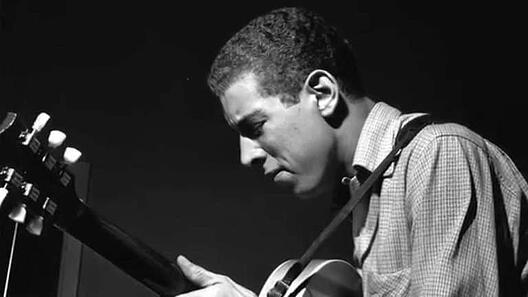In the annals of jazz history, the name Kenneth Earl Kenny Burrell gleams with the brilliance of an original legend in the realm of jazz guitar. Born in the vibrant musical crucible of Detroit, Michigan, he was nurtured amidst a cadre of equally iconic figures who would go on to etch their names into the tapestry of 1950s jazz. Among these luminaries were the illustrious Jones brothers (Thad, Hank, Elvin), the virtuoso Tommy Flanagan, the polymathic Yusef Lateef, and the bass virtuoso Paul Chambers, to name but a few. Burrell’s musical essence was meticulously hewn from the diverse timbres of electric blues, the nascent tendrils of original (proto) bebop, and the classical guitar, creating a tapestry of sound as diverse as it was beguiling.

The result? A sonic signature that resonated with a duality, simultaneously refined and raw, eloquent and boisterous. Burrell’s guitar prowess traversed a rich spectrum – he could craft exquisite unaccompanied chordal passages that resonated with poignant beauty, unleash frenetic barrages of single notes that reverberated with intensity, weave supple blues vamps that entranced the soul, and conjure swinging bebop lines that danced through the air. These seemingly disparate ideas coalesced harmoniously, a testament to a musician whose creative compass was unwavering.
Read More : Eye Acting – Clarifying Inner Thoughts and Feelings
Kenny Burrell’s status as a studio maestro in high demand is undeniable, leaving an indelible mark on the recorded landscape of his time. A period when the boundaries between pop and jazz blurred into a nebulous realm (a phenomenon that would be further transformed in the post-Beatles era).
In his own words, “I like a fat warm sound, so I set the treble lower, the bass medium, and I pump up the middle.” This quote encapsulates his tonal predilections, a key facet of his sonic identity.
Yet, Burrell’s impact transcends the stage and studio. He embodies the duality of performer and educator, holding the prestigious position of director within the Jazz Studies program at UCLA. This role blossomed from his dedication to a course he began teaching in 1978 – “Ellingtonia.” Under his guidance, the UCLA jazz program has thrived, boasting an ensemble of luminaries within its faculty.
Playing Style and Gear
Turning our gaze to his choice of instruments, Burrell’s guitar journey predominantly traversed the territory of Gibsons throughout his illustrious career. The ES-175, with its distinctive Charlie Christian bar pickup, as well as the L-7 and L-5 models, marked the early stages of his sonic odyssey. Yet, it is the iconic Gibson Super 400 that most indelibly echoes his musical persona. Additionally, a signature model from Heritage, essentially a Super 400 incarnation, further attests to his legendary status. During the 1950s, the resonant echoes of his music often emanated from the depths of his Fender Deluxe amp, also known as the Tweed Deluxe or 5E3. This amplifier’s sonic signature is characterized by its musical overdrive and compression attributes, meticulously emphasizing mid-range frequencies.
Read More : The Elements Of Character
As the sands of time flowed, Burrell’s sonic leanings found solace in the arms of the Fender Twin Reverb. The scooped mids inherent to the blackface Fenders juxtaposed the Tweed amps, serving as a canvas for his tonal artistry. In his own words, “I like a fat warm sound, so I set the treble lower, the bass medium, and I pump up the middle.”
In terms of his playing style, Kenny Burrell’s musical lexicon drew upon the rich wellspring of electric blues maestros like T-Bone Walker and BB King, while also imbibing the more linear approach of proto-bebop pioneer Charlie Christian. The 1950s bore witness to the advent of what would come to be known as Hard Bop (arguably a response to the West Coast Cool Jazz phenomenon) and the burgeoning genre of Soul Jazz.
Within this musical cauldron, Burrell stood as a central figure, his playing a testament to the era’s zeitgeist. Detroit, his birthplace, acted as the crucible for an entire generation of musicians who would go on to define these genres. Kenny Burrell not only absorbed but also profoundly influenced this evolving musical language. He was there, and his guitar spoke with fiery pentatonic runs, subtle vibrato, cascading block chord passages, lyrical glissando, and the graceful execution of pull-offs – all punctuated by a rhythmic eloquence that flowed from his fingers, imbuing every note with a gorgeously round tone.





More Stories
Lab-Grown Diamond Engagement Rings: Perfect for Sheffield Couples
Why SMBs Should Invest in Travel Management Software?
How To Sponge Paint Your Floors